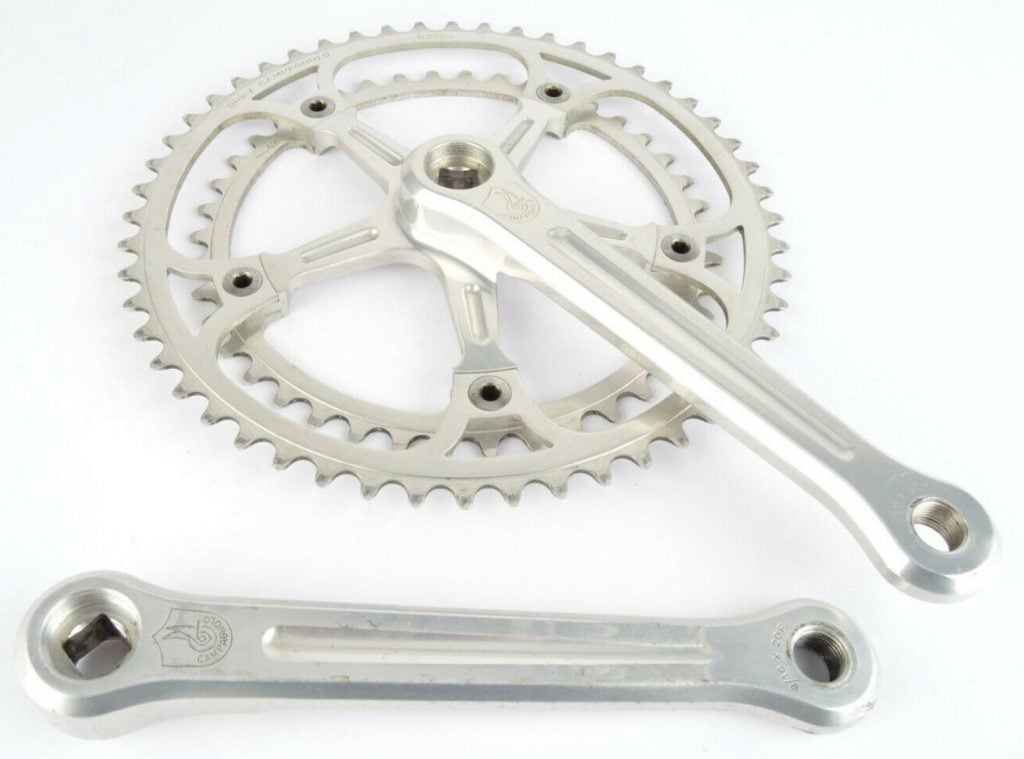
History
Campagnolo Super Record was released in 1974 as the successor to Campagnolo’s top tier group set, Nuovo Record. The Super Record group set was in production from 1974 to late 1980’s. During this period, Campagnolo also released 2 special editions of this group set which featured variations of this alloy crankset. This beautiful crankset (chainwheel set) features clean and classic lines and features a satin silver anodized finish. The only downside being the anodising can wear off with shoe rub over time.
Super Record vs Record Crankset

Right: Campagnolo Super Record Crankset (1049/A)
Looking at the various Campagnolo catalogues from 1973 to 1984, it appears that the only difference between these cranksets was the chain rings. Record chain rings feature more material. Super Record chain rings used less material which made them lighter and more beautiful (in my opinion).
Crank Length Options
According to the 1984 Campagnolo catalogue, the Super Record group set included 170mm crank length as standard, however these other sizes could be ordered on request; 165mm, 167.5mm, 172.5mm, 175mm, 177.5mm & 180mm.
Looking at the underside of both cranks you will find the size imprinted eg. 170 = 170mm crank length as illustrated. ‘STRADA’ is Italian for ‘Street’ or road bike cranks.
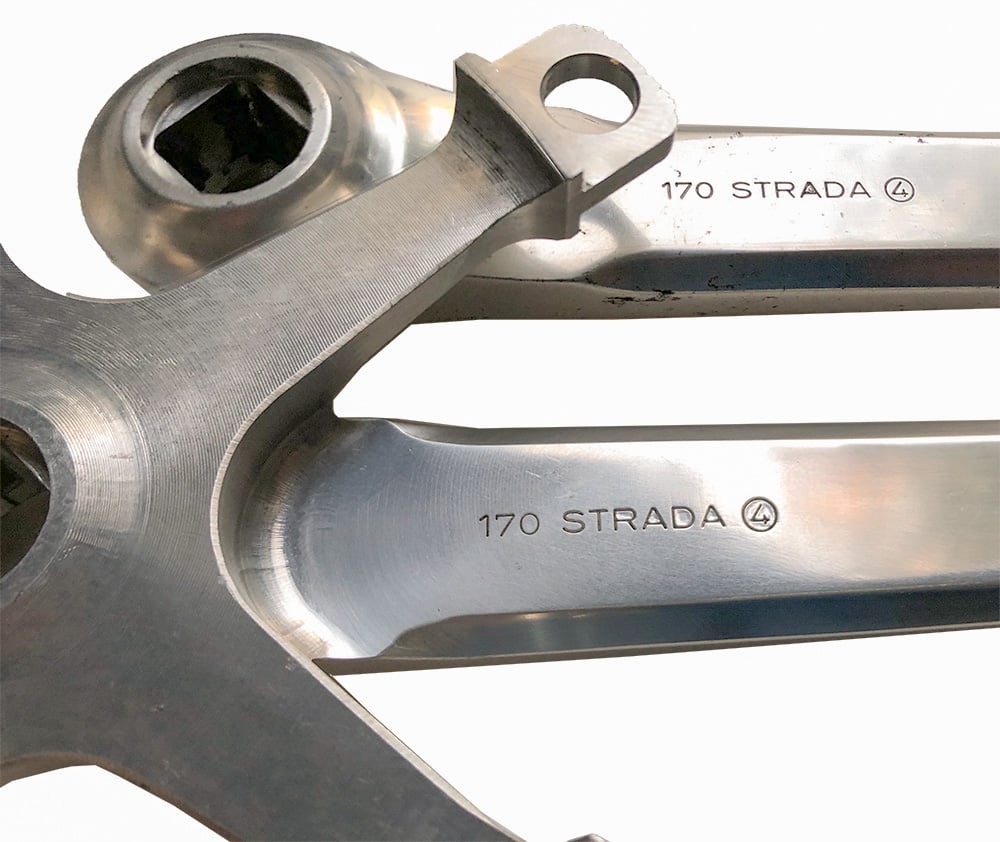
Manufacturing Date
Campagnolo included a date code on their Super Record crank sets. For example, looking at the image above, you can see a 4 in a circle. This means the cranks were manufactured in 1984. Other date codes are as follows;
Year
1973 to 1979
1980 to 1984
1985
1986
1987
Marking
Year of manufacture; last digit in a diamond.
Year of manufacture: last digit in a circle.
’11’ in a rectangle.
’22’ in a rectangle*.
’33’ in a rectangle*.
Notes: *I have found an alternate theory that says 1986 is 2x and 1987 is 3x; where ‘x’ supposedly represents the quarter in which it was manufactured.
Chain Ring Sizes
The 1984 Campagnolo catalogue specifies that chain rings could be ordered in sizes from 42 to 57 teeth. The smallest chain ring of 42 teeth is considerably larger than modern day chain rings where a 34 tooth chain ring is considered to be probably the smallest chain ring for standard road bike gearing. Even the professionals regularly ride with a smallest chain ring of 39 teeth.
If you need to replace any chain rings, the Bolt Circle Diameter (BCD) for the Super Record crankset is 144mm.
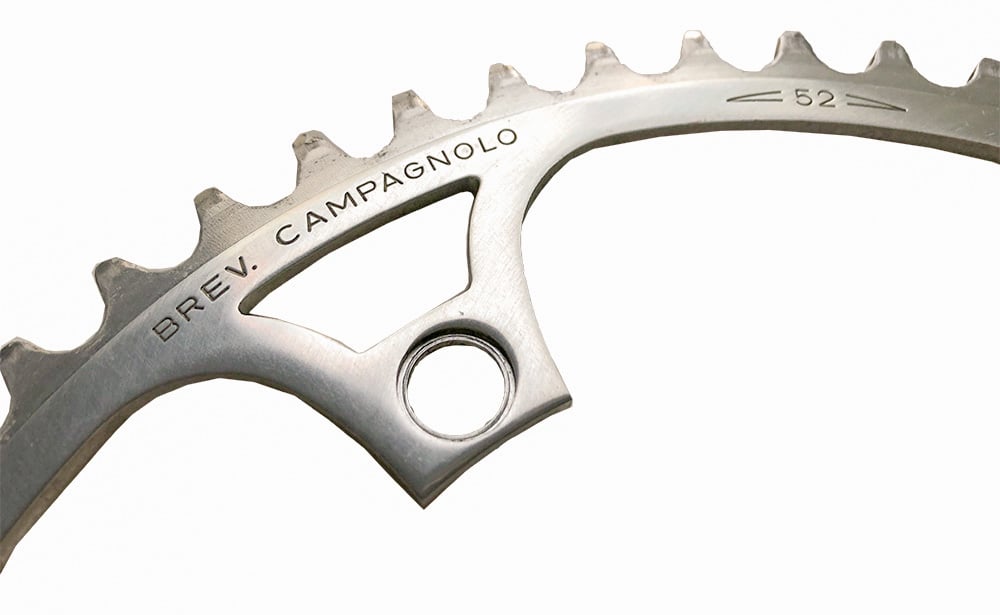
Most of the cranksets I have seen advertised on E-bay are fitted with 52t / 42t chain rings, so I expect this was the standard set-up supplied in the group set. These chain rings are designed for use with a 1/2″ x 3/32″ chain (2mm).
Crank Pedal Threads
These cranks are designed to fit any pedal with a standard 9/16″ x 20 F threading. This threading is still used with modern pedals which means you can also use modern clipless pedals with this crankset should you not wish to use traditional pedals and toe clips on your vintage bike.
Assembling the Chain Rings
The Campagnolo chain rings actually have a front and back side and therefore need to be fitted in the correct orientation on the spider. In the image below, the small chain ring is fitted onto the rear of the spider.
Looking at the top hole, you will notice that the hole is actually counter-sunk. This allows the flange of the threaded nut to sit flush inside this hole when the crankset is assembled. The same applies to the large chain ring.
When assembled correctly you will find the number of teeth imprinted on the large chain ring eg. <52> will face out away from the frame (visible on right side of bike) and the number of teeth imprinted on the small chain ring eg. <42> will face in toward the frame (visible on left side of bike).
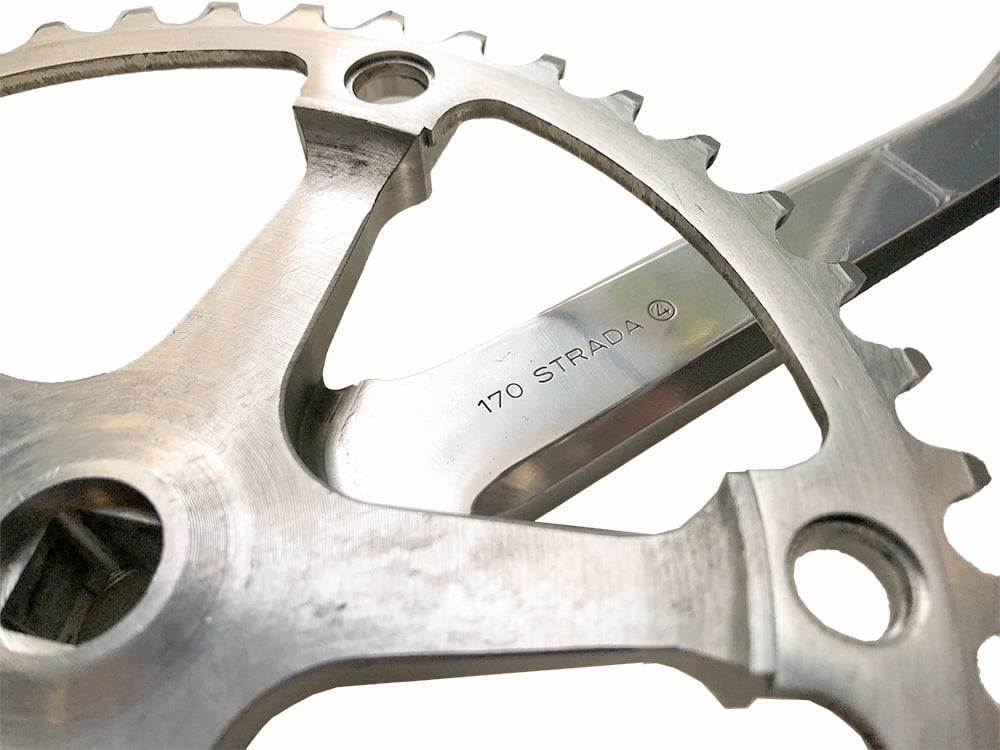
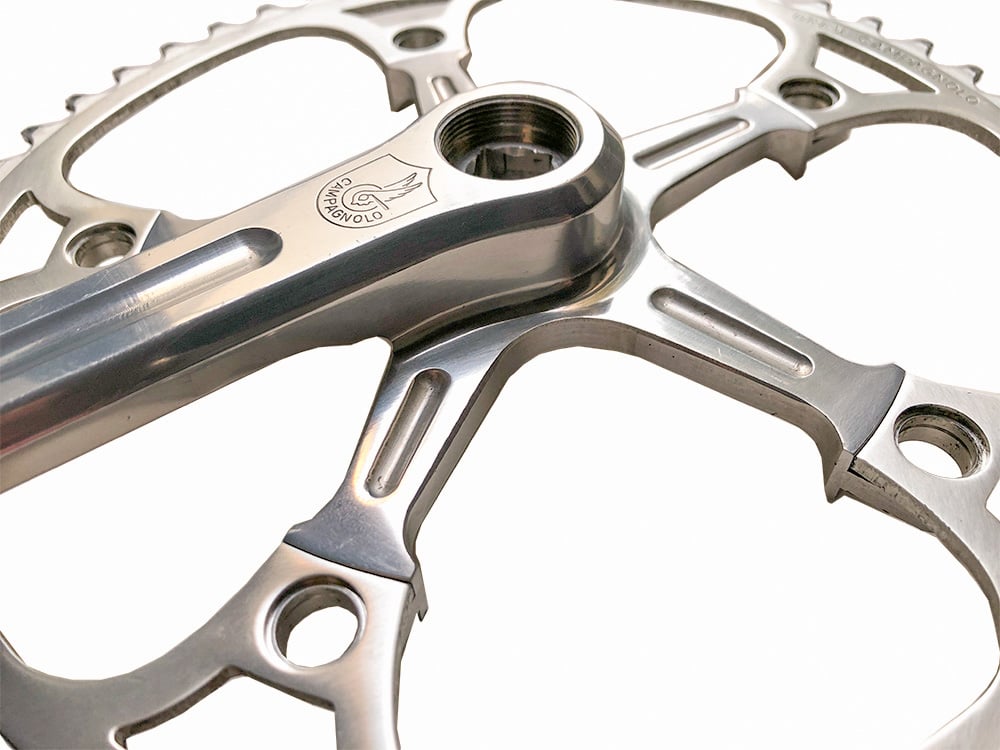
The chain ring bolts appear to be made from steel and are very durable. They can be removed easily using a 5mm allen key and a standard chain ring nut wrench. When you refit the nuts, you can use grease or alternatively add a drop of Loctite to ensure that they don’t come loose over time.


Campagnolo Crankset Dust Covers
Campagnolo Super Record Cranksets were supplied with some light weight chrome threaded dust covers that are designed to hide the bolts that fix the crank to the axle in the bottom bracket.

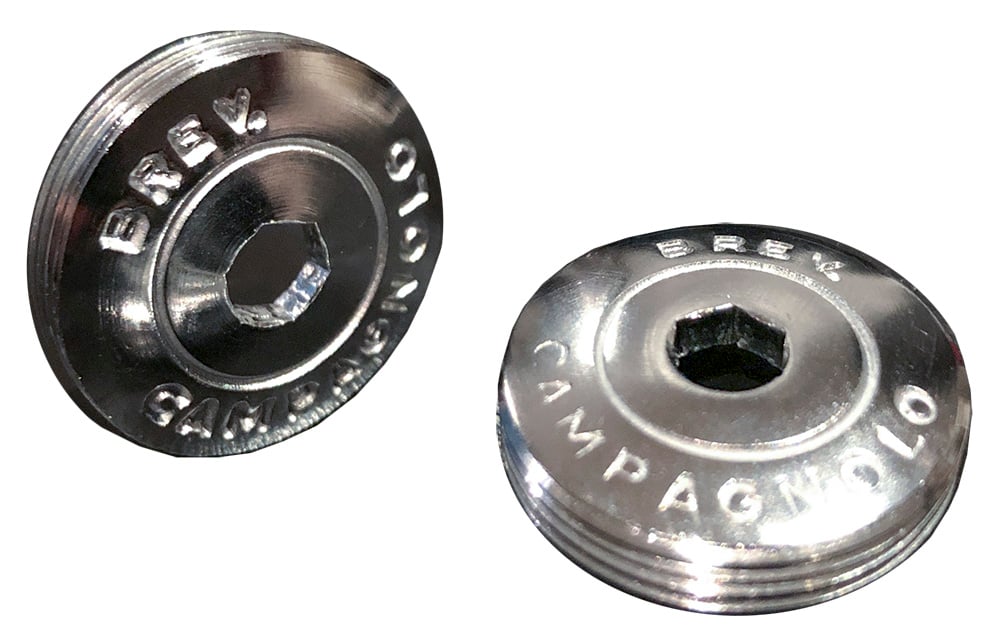
Thankfully you buy aftermarket dust covers should you ever loose one.
As you can see in the photo, the original dust cover has a little bit thinner lettering than the aftermarket cover.
However once they are fitted to the cranks it would be difficult to notice the difference and using the covers gives the crank a cleaner look. A 5mm allen key is used to fit or remove the covers.
Last Generation Super Record Crankset
Whilst the Super Record crankset was brilliant, some riders experienced stress fractures where the spider joined the right side crank arm. However, I believe this area was reinforced in the final few years of production with the release of a last generation update which was easy to identify as the arms were not fluted (just like the 50th Anniversary version). Looking at the photo below, it appears the spider was also reinforced on the underside of the crank arm to prevent cracking.
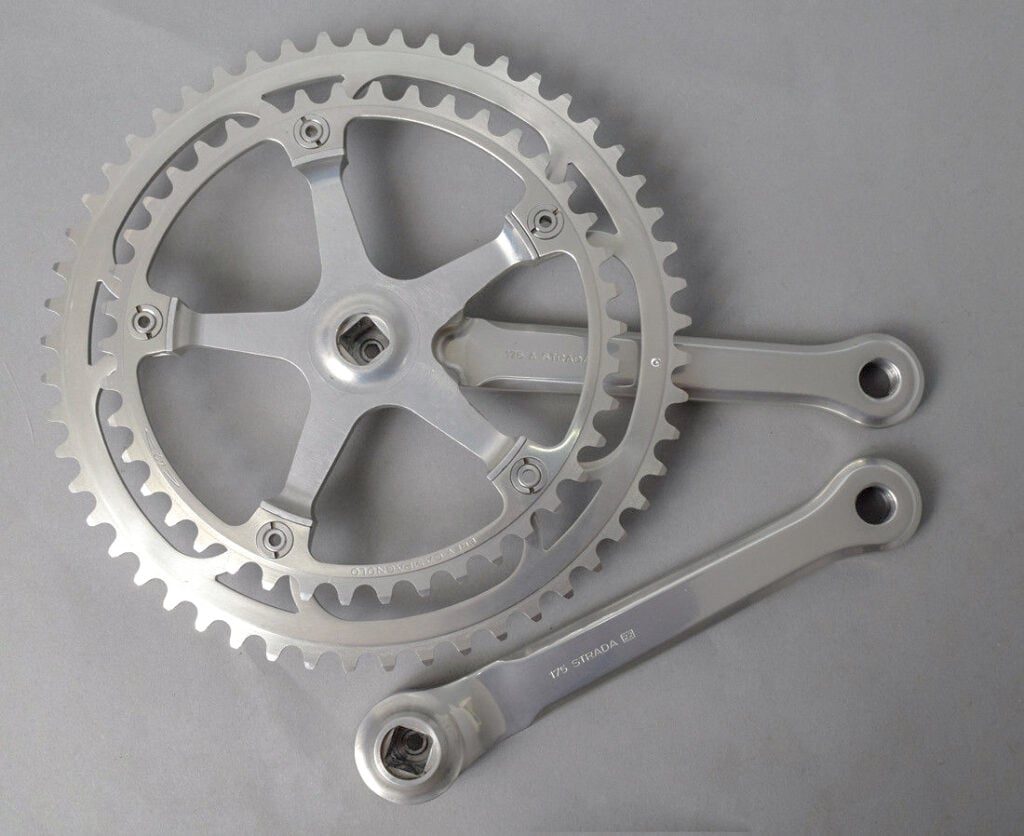

No flutes engraved on the top of the crank arms.
Campagnolo 50th Anniversary Crankset
To celebrate the 50th anniversary of Campagnolo in 1983, they created a limitied edition version of the Super Record group set. This crankset features dust caps with gold inserts and special 50th anniversary markings.
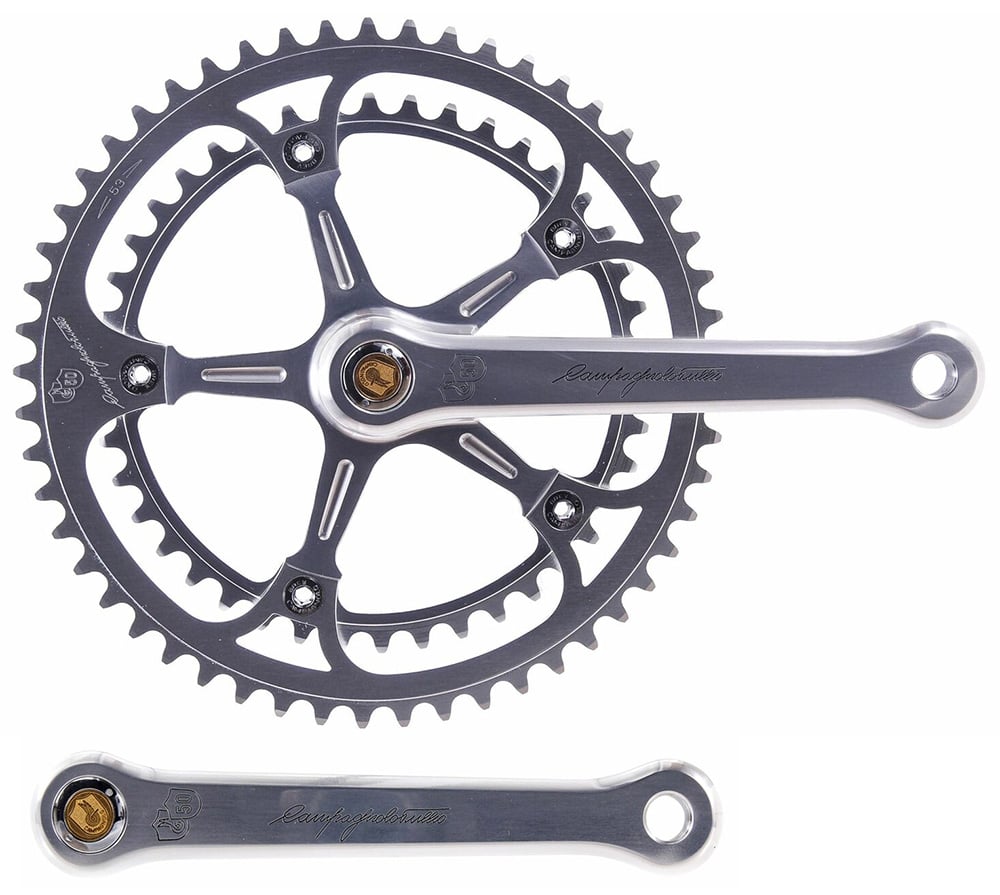
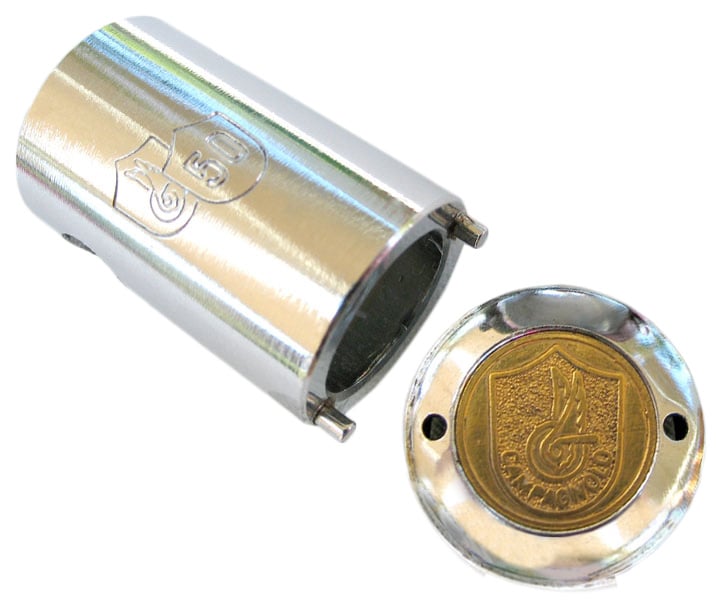
The Campagnolo 50th Anniversary group set includes a special dust cover installer/removal tool as pictured.
I believe this tool can also be used to install / remove the Colnago 30th Anniversary dust covers as they were the same design.
Colnago 30th Anniversary Crankset
In 1984 Campagnolo manufactured a special version of the Super Record group set for Colnago to celebrate the 30th Anniversary of Colnago (founded in 1954). These group sets are very rare and were originally fitted to a limited release of Colnago Arabesque bicycles.

Parts Schematic

You will note that the parts schematic does not show the 2 x bolts & washers that are used to fix the cranks to the bottom bracket axle. These bolts are considered to be part of the bottom bracket assembly, however when purchasing these parts second hand, sometimes the bolts included with the cranks, sometimes they are included with the bottom bracket – it just depends on the seller.
Super Record Component Weight
I have weighed a set of Super Record components and quite surprisingly, these vintage parts compares quite favourably against the weight of a modern Campagnolo Super Record group set.
Learn more about Campagnolo Super Record
This article is just a small part of my full review of Campagnolo Super Record groupset.
I hope you found this article interesting. I have listed the following website pages as general references.
vintagecannondale.com/info/campagnolo
www.sheldonbrown.com/cribsheet-bcd.html
Disclaimer!
Please remember that this information is only to be used as a guide.
I consider myself an enthusiast, not an expert. The information I have presented in this article is based on my many hours of online research.
Whilst I enjoy working on my own bikes, I am not a qualified bicycle mechanic. The content of this article is purely illustrative and does not constitute professional advice. For your own safety, any type of work should only be undertaken by a qualified bicycle mechanic. Incorrect assembly of parts could result in equipment damage, personal injury or death.
About Me.
I have been riding and working on my own bikes for many years now. I wanted to share my experiences, knowledge and research with others. My aim is to inspire people to get involved in all aspects of this amazing sport. Cheers.
Comments.
I welcome reader feedback in the comments section. Should you wish to suggest an amendment, please include a note advising the source of your information so that myself and other readers can ascertain the accuracy of your information. Note: Trolling or argumentative comments will be removed as they are counter-productive.
Hello,
If there is no date number in the crank or rear derailleur, What aretheyears of Production?
Thank you
Stefan Roosen
Hi Stefan,
Interesting question.
1. According to this website, the cranks are pre-1973 if there is no date code.
2. According to this website, the rear derailleur is 1986/1987 if there is no date code.
Hi I wonder if you can help me please. I am stripping my old steel Bianchi and would like to remove the cranks to allow me to get it resprayed. Do I need a special campy crank puller. Are the threads different to later everyday ones?
very many thanks.
Hi Paul, I used just a cheap and basic (non-Campagnolo) regular crank pulling tool. The tool should easily thread into the cranks, just make sure not to cross-thread it.
Congratulations on some valuable information, well presented. Some observations…
Those Colnago anniversary groupsets weren’t specially made for Colnago by Campagnolo. They were standard Campagnolo parts modified by Colnago. Anodising was stripped using a caustic solution. The parts were very heavily polished. Pantograph-engraved graphics were applied. The work was almost certainly not done by Colnago themselves, but by one of the several modification houses that carried out pantograph customising work on Campagnolo components for many different bike brands.
The last version of the Record cranks had no fluting beacause of cases of arms cracking from the flute. The two raised longitudinal “webs” that result either side of the flute are stressed in tension during pedalling, as the crank arm is deformed inward at the bottom of the stroke and the webs are effectively stretched. There are relatively sharp edges from the machining. This led to cases of fatigue cracking, especially when the anodising had been rubbed away by toe-straps and surface disruption from corrosion had occured. In many cases a catastrophic failure resulting in injury would happen. I have seen this with my own eyes with fluted Record cranks on two occasions. Fortunately the injuries were not serious, just bloody knees and elbows. A stress riser in tension, with the surface distrurbed by corrosion, is the “perfect storm” for failure of stressed aluminium components. We look back on this stuff through rose-tinted specs, but some of it had obvious design and manufacturing flaws which weren’t addressed quickly enough. Shimano’s Dura-Ace EX Dyna-Drive Aerodynamic cranks of 1979 have a smooth, rounded shape not only for aerodynamics, but also to avoid stress risers. The “offset spider” of that design was to avoid a fragile web of sharp aluminium where the spider adjoins the crank arm at acute angles with tight radii. Mainstream brands went away from sharp, machined edges and flutes eventually. Small CNC brands kept with it, but CNC cranks, stems and hub flanges are notorious for fatigue failure! Stressed aluminium components should always be cold forgings with rounded edges – and good quality anodising. It is notable that Campagnolo’s non-anodised components – namely hubs and seat posts – are known to suffer from corrosion and resulting fatigue failure. I cannot think why posts and hub shells would not be anodised like the rest of the parts in the group. This problem carried over from Nuovo/Super Record to C-Record, with stuck and broken seat posts and cracked hub flanges not unusual. And, with “Sheriff Star” hubs they added a really efficient mechanical stress riser in the form of small radius corners to the cut-outs in the flanges. C-Record really was a period of form before function. It all looked great, but was very heavy and didn’t work well. An SLX framed bike with C-Record Delta/Ergo weighs over 11 Kg!!! Vintage Record and Super Record is lovely stuff (better than C-Record!), but riders of vintage bikes should be very wary of the potential for “safety critical” component failures. Old components should not be heavily stressed. Components with even mild corrosion should not be used. Components known for failure BITD should be avoided today, obviously. Just display it in a glass cabinet or fit it to a “wall hanger” bike instead. Stay safe. Ride free.
Hi David, thanks for posting your comments. Definately some interesting insights. I had read something similar as to why Campagnolo removed the flute from the Super Record cranks. Luckily the parts on my bikes are in good condition and seem to be holding up well, but I will definitely keep an eye om them. Cheers.
Ciao amici, I’ve got set of Gran Sport cranks, with a zero in a circle so possibly 1980, they’re non fluted. I’m trying to put them on an 82 ALAN Super Leggera. I’ve bought the longest campagnolo spindle I can find but the drive side bottoms out on the chain stay. Has anyone else had this issue; is there something I’m missing?
I love Italian gear but there’s always issues, doing Restoes on cars, motos and pushies is so much easier when they’re Japanese, Danish furniture is a dream.
Cheers
Hi James, I presume you fitted the bottom bracket axle in the correct orientation as the drive side end is slightly longer than the non-drive side end.? Perhaps my article on Vintage Campagnolo Record Bottom Bracket will help you determine the correct bottom bracket to suit your needs as they are available in different lengths. Instructions on how to install the bottom bracket can be found on How to Install a Vintage Campagnolo Bottom Bracket.
Can this cranks can do in single speed set up? Even if it is for dual chainring??
I don’t have any experience with single speed setups. I believe Campagnolo did a SR Pista (track) chainset and it looks very similar to the SR Road chainset, but with a single chain ring.